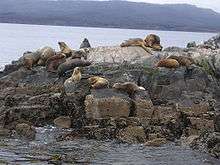Tierra del Fuego
Tierra del Fuego (/tiˈɛərə dɛl ˈfweɪɡoʊ/, Spanish: [ˈtjera ðel ˈfweɣo]; Spanish for "Land of Fire", formerly also Fireland in English) is an archipelago off the southernmost tip of the South American mainland, across the Strait of Magellan. The archipelago consists of the main island, Isla Grande de Tierra del Fuego, with an area of 48,100 km2 (18,572 sq mi), and a group of many islands, including Cape Horn and Diego Ramírez Islands. Tierra del Fuego is divided between Chile and Argentina, with the latter controlling the eastern half of the main island and the former the western half plus the islands south of Beagle Channel. The southernmost extent of the archipelago is at about latitude 55 S.
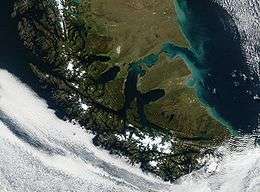 Tierra del Fuego archipelago in the bottom half of the image | |
 Tierra del Fuego archipelago Political map of Tierra del Fuego and mainland South America | |
| Geography | |
|---|---|
| Location | Pacific Ocean, Atlantic Ocean |
| Major islands | Tierra del Fuego, Hoste, Navarino, Gordon, Wollastone, Noir, Staten, Hermite, Santa Inés, Clarence, Dawson, Capitán Aracena, Londonderry, Picton, Lennox, Nueva, Diego Ramírez, O'Brien, and Desolación Islands among many others |
| Highest point | Monte Shipton |
| Administration | |
| Region | |
| Provinces | Tierra del Fuego Province and Antártica Chilena |
| Communes | Cabo de Hornos, Antártica, Porvenir, Primavera, Timaukel |
| Province | |
| Demographics | |
| Population | >135,000 (2010) |
| Ethnic groups | Argentines, Chileans, Selknams, Kawésqar, Yaghans |
The earliest known human settlement in Tierra del Fuego dates to around 8,000 BCE.[1] Europeans first explored the islands during Ferdinand Magellan's expedition of 1520; Tierra del Fuego and similar namings stem from sightings of the many bonfires that the natives built. Settlement by those of European descent and the great displacement of the native populations did not begin until the second half of the 19th century, at the height of the Patagonian sheep farming boom and of the local gold rush.[2] Today, petroleum extraction dominates economic activity in the north of Tierra del Fuego, while tourism, manufacturing, and Antarctic logistics are important in the south.
History
Prehistory and European exploration
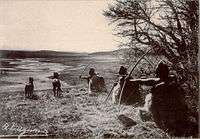
The earliest human settlement occurred around 8,000 BCE. The Yaghan were some of the earliest known humans to settle in Tierra del Fuego. Archeological sites with characteristics of their culture have been found at locations such as Navarino Island.[3]
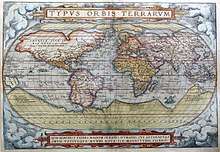
The name Tierra del Fuego was given by the Portuguese explorer Ferdinand Magellan while sailing for the Spanish Crown in 1520; he was the first European to visit these lands. He believed he was seeing the many fires (fuego in Spanish) of the Yaghan, which were visible from the sea, and that the "Indians" were waiting in the forests to ambush his armada.[4]
In 1525 Francisco de Hoces was the first to speculate that Tierra del Fuego was one or more islands rather than part of what was then called Terra Australis. Francis Drake in 1578 and a Dutch East India Company expedition in 1616 learned more about the geography. The latter expedition named Cape Horn.
On his first voyage with HMS Beagle in 1830, Robert FitzRoy picked up four native Fuegians, including "Jemmy Button" (Orundellico) and brought them to England. The surviving three were taken to London to meet the King and Queen and were, for a time, celebrities. They returned to Tierra del Fuego in Beagle with FitzRoy and Charles Darwin, who made extensive notes about his visit to the islands.
European colonization and extinction of Native Americans (1860–1910)
.jpg)
During the second half of the 19th century, the archipelago began to come under Chilean and Argentine influence. Both countries sought to claim the whole archipelago based on de jure Spanish colonial titles. Salesian Catholic missions were established in Río Grande and Dawson Island.
Anglican missions were established by British colonists at Keppel Island in the Falklands in 1855 and in 1870 at Ushuaia on the main island, which continued to operate through the 19th century. Thomas Bridges (1842–1898) learned the language and compiled a 30,000-word Yaghan grammar and dictionary while he worked at Ushuaia.[5] It was published in the 20th century and considered an important ethnological work.[5]
An 1879 Chilean expedition led by Ramón Serrano Montaner reported large amounts of placer gold in the streams and river beds of Tierra del Fuego. This prompted massive immigration to the main island between 1883 and 1909. Numerous Argentines, Chileans and Croatians settled in the main island, leading to increased conflicts with native Selk'nam.
Julius Popper, a Romanian explorer, was one of the most successful entrepreneurs in the region. Granted rights by the Argentine government to exploit any gold deposits he found in Tierra del Fuego, Popper has been identified as a central figure in the Selk'nam genocide.
Following contact with Europeans, the native Selk'nam and Yaghan populations were greatly reduced by unequal conflict and persecution by settlers, by infectious diseases to which the indigenous people had no immunity, and by mass transfer to the Salesian mission of Dawson Island. Despite the missionaries' efforts, many natives died. Today, only a few Selk'nam remain. Some of the few remaining Yaghan have settled in Villa Ukika in Navarino Island; others have scattered across Chile and Argentina.
Following the signing of the Boundary Treaty of 1881, Tierra del Fuego was divided between Argentina and Chile; previously, it had been claimed in its entirety by both countries.
The gold rushes of the late 19th century led to the founding of numerous small settlements by immigrants such as the Argentine settlements of Ushuaia and Río Grande and the Chilean settlements of Porvenir and Puerto Toro.
Recent history (1940–present)
In 1945 a division of Chilean CORFO (Spanish acronym for Production Development Corporation) engaged in oil exploration made a breakthrough discovery of oil in northern Tierra del Fuego. Extraction began in 1949, and in 1950 the state created ENAP (National Petroleum Company) to deal with oil extraction and prospecting. Until 1960, most oil extracted in Chile came from Tierra del Fuego.[6]
During the 1940s Chile and Argentina formulated their Antarctic claims. The governments realized the key role of Tierra del Fuego's geographical proximity in backing their claims as well as in supplying their Antarctic bases. In the 1950s, the Chilean military founded Puerto Williams to counter Ushuaia's monopoly as the only settlement in the Beagle Channel, a zone where Argentina disputed the 1881 borders.
In the 1960s and 1970s, sovereignty claims by Argentina over Picton, Lennox and Nueva Islands in Tierra del Fuego led the two countries in December 1978 to the brink of war. In response to the threat of an Argentine invasion, minefields were deployed and bunkers built on the Chilean side in some areas of Tierra del Fuego. The threat of war caused the Chilean Pinochet regime to give logistical support and information to the British during the Falklands War of 1982. Chilean radar supplied the British with information on Argentine jet movements in Tierra del Fuego, from where the Argentine Air Force launched raids on targets in the Falklands.
In 1986 the Argentine congress decided that the Argentine part of Tierra del Fuego should be a new province; the law was not promulgated until 26 April 1990.[7]
Geography
.jpg)

The archipelago consists of a main island, Isla Grande de Tierra del Fuego, often called simply Tierra del Fuego or Isla Grande, with an area of 48,100 km2 (18,572 sq mi), and a group of smaller islands. Of the main island the westernmost 29,484.7 km2 (11,384 sq mi, 61.43%) belongs to Chile, and 18,507.3 km2 (7,146 sq mi, 38.57%) belongs to Argentina. The archipelago is divided by an east–west channel, the Beagle Channel, immediately south of the main island. The largest islands south of the Beagle Channel are Hoste and Navarino.
The western part of the main island, and almost all the other islands, belong to Chile. They are part of the Magallanes y Antártica Chilena Region, the capital and chief town of which is Punta Arenas, situated on the mainland across the strait. The biggest Chilean towns are Porvenir, capital of the Chilean Province of Tierra del Fuego, located on the main island; and, on Navarino Island, Puerto Williams, which is the capital of the Antártica Chilena Province. Puerto Toro lies a few kilometers south of Puerto Williams and is arguably the southernmost village in the world. The mostly uninhabited islands north and west of the main island are part of Magallanes Province.
The eastern part of the main island, and a few small islands in the Beagle Channel, belong to Argentina. They are part of the Tierra del Fuego, Antarctic Territory and South Atlantic Islands Province, whose capital is Ushuaia, the biggest city of the archipelago. The other important city in the region is Río Grande on the Atlantic coast.
The Cordillera Darwin in the southwestern part of the main island contains many glaciers that reach the ocean. While Mount Darwin had previously been thought to be the tallest mountain in the archipelago, this distinction actually belongs to the unofficially named Monte Shipton at 2,580 metres (8,460 feet).[8]
The topography can be divided into four regions: an outer archipelago region (Spanish: Región Archipielágica) to the south and west, a mountain region in the south (Spanish: Región Cordillerana),[9] a plains region (Spanish: Región de las Planicies Orientales)[10] plus a sub-Andean zone in-between the last two zones (Spanish: Región Sub-Andina Oriental).[11]
Geology
The geology of the archipelago is characterized by the effects of the Andean orogeny and the repeated Pleistocene glaciations. The geology of the island can be divided into large east–west-oriented units. The southwestern islands of the archipelago, including Cape Horn, are part of the South Patagonian Batholith, while Cordillera Darwin and the area around Beagle Channel form the principal cordillera hosting the highest mountains. The Magallanes fold and thrust belt extends north of Almirantazgo Fjord and Fagnano Lake, and north of this lies the Magallanes foreland; an old sedimentary basin that hosts hydrocarbon reserves.[12] Orthogneiss dated at 525 million years is known to underlie some of the oil wells in northern Tierra del Fuego.[13]
The Magallanes–Fagnano Fault, a sinistral strike slip fault crosses the southern part of the main island from west to east. It is an active fault, located inside and parallel to the Fuegian fold and thrust belt, and marks the boundary between a southern belt of Paleozoic meta sediments and a northern Mesozoic belt of sedimentary sequences. Fagnano Lake occupies a glacier-carved depression in a pull-apart basin that has developed along the Magallanes-Fagnano Fault zone.[14]
Podzols and inceptisols occur beneath Nothofagus betuloides forests in Tierra del Fuego.[15]
Climate

This region has a subpolar oceanic climate (Köppen climate classification Cfc) with short, cool summers and long, wet, moderately mild winters: the precipitation averages 3,000 mm (118 in) a year in the far west, but precipitation decreases rapidly to the eastern side. Temperatures are steady throughout the year: in Ushuaia they hardly surpass 9 °C (48 °F) in summers and average 0 °C (32 °F) in winters. Snowfall can occur in summer. The cold and wet summers help preserve the ancient glaciers. The southernmost islands possess a sub-antarctic climate typical of tundra that makes the growth of trees impossible. Some areas in the interior have a polar climate. Regions in the world with similar climates to southern Tierra del Fuego are: the Aleutian islands, Iceland, the Alaska Peninsula, the Faroe Islands, Macquarie Island, and the Heard and McDonald Islands.
Flora
Only 30% of the islands have forests, which are classified as Magellanic subpolar. The northeast is made up of steppe and cool semi-desert.
Six species of tree are found in Tierra del Fuego: canelo or winter's bark (Drimys winteri), Maytenus magellanica, Pilgerodendron uviferum, the southernmost conifer in the world, and three kinds of southern beech: Nothofagus antarctica, Nothofagus pumilio, and the evergreen Nothofagus betuloides. Several kinds of fruit grow in open spaces in these forests, such as beach strawberry (Fragaria chiloensis var. chiloensis forma chiloensis) and calafate (Berberis buxifolia), which have long been gathered by both Native Americans and residents of European descent.[16] They are the only forests in the world to have developed in a climate with such cold summers. Tree cover extends very close to the southernmost tip of South America. Winds are so strong that trees in wind-exposed areas grow into twisted shapes, inspiring people to call them "flag-trees". Tree vegetation extends as far south as the Isla de los Estados, Navarino Island, and the northern part of Hoste Island. Dwarf nothofagus communities are found at altitudes above 500 m (1,640 ft). Going farther south, Wollaston Islands and the southern part of Hoste Island are covered by subantarctic tundra.
- Flora in Tierra del Fuego
 Drimys winteri flowers
Drimys winteri flowers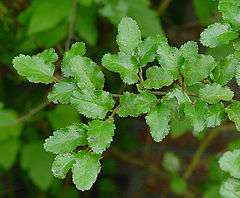
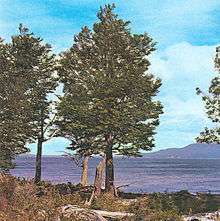
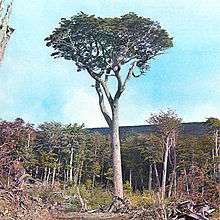
Forests from Tierra del Fuego have expanded beyond local importance; they have been a source of trees that have been planted abroad in places with practically the same climate but which were originally devoid of trees, such as the Faroe Islands and nearby archipelagos. Most species were gathered from the coldest places in Tierra del Fuego, mainly sites with tundra borders. This effort resulted in positive changes, as the heavy winds and cool summers in the Faroe Islands did not allow the growth of trees from other regions in the world. The imported trees are used ornamentally, as curtains against wind, and for fighting erosion caused by storms and grazing in the Faroe Islands.[17]
Fauna
Among the most notable animals in the archipelago are austral parakeets, sea gulls, guanacos,[18] foxes, kingfishers, condors, king penguins, owls, and firecrown hummingbirds.[19]
North American beavers, introduced during the 1940s, have proliferated and caused considerable damage to the island's forests. The governments have established a wide-reaching program to trap and kill beavers in Tierra del Fuego.[20]
Like the mainland of Chile and Argentina to the north, this archipelago boasts some of the finest trout fishing in the world. Sea-run brown trout often exceed 9 kg (20 lb), particularly in rivers such as the Rio Grande and the San Pablo and in the Lago Fagnano. Much of this water is privately owned, with catch and release and fly fishing only.
Waters adjacent to Tierra del Fuego are very rich in cetacean diversity.[21] Sightings of southern right whales in Tierra del Fuego[22] have increased in the 2000s,[23] as well as humpbacks[24][25] and some others such as blue whales,[26] southern fins, southern seis,[27] and southern minkes.[28][29] Beagle Channel is a prominent area to watch rare, endemic dolphins,[30] and the less-studied pygmy right whales.
Pinnipeds inhabiting the areas include South American sea lions (Otaria flavescens),[31][32] South American fur seals (Arctocephalus australis),[33][34] carnivorous leopard seals (Hydrurga leptonyx)[35] (seal-eating seal) and gigantic southern elephant seals (Mirounga leonine).[36][37]
Economy
Today, the main economic activities of the archipelago are fishing, natural gas and oil extraction, sheep farming, and ecotourism. Tourism is gaining in importance and becoming increasingly important as it attracts numerous upmarket visitors. Much of the tourism is based on "southernmost" claims: for example, both Ushuaia and Puerto Williams claim to be the "southernmost city in the world." On the Argentine side of Tierra del Fuego, the government has promoted the establishment of several electronic companies via tributary exemptions, particularly in the city of Río Grande.
Energy production is a crucial economic activity. On the Argentine side of Tierra del Fuego during the 2005 to 2010 period, petroleum and natural gas extraction contributed to 20% of the region's economic output.[38]
See also
Notes
- Morello, Flavia; Borrero, Luis; Massone, Mauricio; Stern, Charles; García-Herbst, Arleen; McCulloch, Robert; Arroyo-Kalin, Manuel; Calás, Elisa; Torres, Jimena; Prieto, Alfredo; Martinez, Ismael; Bahamonde, Gabriel; Cárdenas, Pedro (1 March 2012). "Hunter-gatherers, biogeographic barriers and the development of human settlement in Tierra del Fuego". Antiquity. 86 (331): 71–87. doi:10.1017/S0003598X00062463. hdl:1893/3664.
- Iparraguirre, Sylvia. Tierra del fuego: a biography of the end of the world. p. 146.
- Hogan, C. Michael (4 April 2008). "Bahia Wulaia Dome Middens". Megalithic Portal. Archived from the original on 10 June 2011. Retrieved 20 June 2011.
- Bergreen, Laurence (2003). Over the Edge of the World: Magellan's Terrifying Circumnavigation of the Globe. HarperCollins. p. 179. ISBN 978-0-06-186588-6.
- "Cook Tried to Steal Parson's Life Work" (PDF). New York Times. 21 May 1910. Retrieved 30 May 2011.
- Martinić, Mateo (1982), La Tierra de los Fuegos (in Spanish), Punta Arenas, Chile: Municipalidad de Porvenir, pp. 164–171
- "Historia de Tierra del Fuego" (in Spanish). Tierradelfuego.gov.ar. Archived from the original on 17 July 2011. Retrieved 20 June 2011.
- John Shipton (2004). "Monte Shipton or Monte Darwin?" (PDF). Alpine Journal. London: Alpine Club: 132–142. Retrieved 28 March 2012.
- Pisano (1977), p. 124
- Pisano (1977), p. 128
- Pisano (1977), p. 125
- Menichetti, M.; Lodolo, E.; Tassone, A. (March 2008). "Structural geology of the Fuegian Andes and Magallanes fold-and-thrust belt – Tierra del Fuego Island". Geologica Acta. 6 (1). Archived from the original on 18 July 2011. Retrieved 20 June 2011.
- Hervé, Francisco; Miller, Hubert; Pimpirev Christo. 2003. Patagonia – Antarctica Connections before Gondwana Break-Up in Antarctica Contributions to Global Earth Sciences. Chapter 5.1
- Lodolo, Emanuele; Menichetti, Marco; Bartole, Roberto; Ben‐Avraham, Zvi; Tassone, Alejandro; Lippai, Horacio (2003). "Magallanes-Fagnano continental transform fault (Tierra del Fuego, southernmost South America)". Tectonics. 22 (6): 1076. Bibcode:2003Tecto..22.1076L. doi:10.1029/2003TC001500.
- Gerding, Victor; Thiers, Oscar (2002), "Characterization of soils of Nothofagus betuloides (Mirb) Blume forests, in Tierra del Fuego, Chile", Revista Chilena de Historia Natural (in Spanish), 75 (4): 819–833, doi:10.4067/S0716-078X2002000400015
- Martínez Crovetto, Raúl. 1968. Estudios Etnobotánicos. Nombres de plantas y su utilidad según los indios Onas de Tierra del Fuego, Revista de la Facultad de Agronomía y Veterinaria de la Universidad del Nordeste, Corrientes, Argentina
- Højgaard, A., J. Jóhansen, and S. Ødum (eds) 1989. A Century of Tree Planting in the Faroe Islands, Føroya Frodskaparfelag, Tórshavn.
- "Lama guanicoe". The IUCN Red List of Threatened Species. 3 February 2016. Retrieved 5 July 2020.
- "Sephanoides sephaniodes". The IUCN Red List of Threatened Species. 1 October 2016. Retrieved 5 July 2020.
- Strieker, Gary (9 July 1999). "Argentina eager to rid island of beavers". Cable News Network. Archived from the original on 3 March 2008. Retrieved 30 June 2007.
- https://webcache.googleusercontent.com/search?q=cache:LetUsI438EAJ:iwc.int/document_1215.download+&cd=1&hl=en&ct=clnk&gl=nz%5B%5D
- "Hoy en Rio Grande, Tierra del Fuego (ballena)". Archived from the original on 5 May 2014.
- Goodall, R. Natalie P.; Benegas, G. L.; Dellabianca, N.; Riccialdelli, L.; Pimper, E. L. (17 January 2014). "The Presence of Southern Right Whales off Eastern Tierra del Fuego, 1987–2011" (PDF). Archived from the original (PDF) on 5 May 2014. Retrieved 6 May 2014.
- "Whale Watching in the Southern Cone – Argentina". Archived from the original on 31 May 2014. Retrieved 5 May 2014.
- "Whale Watching in the Southern Cone – Gallery". Archived from the original on 31 May 2014. Retrieved 5 May 2014.
- "Blue Whale (Balaenoptera musculus) on Tierra del Fuego Check List". Archived from the original on 17 September 2016.
- "Minke Whale (Sei Whale?)". Archived from the original on 24 June 2016 – via Flickr.
- "Minke Whale (Balaenoptera acutorostrata) on Tierra del Fuego Check List". Archived from the original on 4 January 2018.
- "Record of a dwarf minke whale (Balaenoptera acutorostrata) in northern Brazil" (PDF). Archived (PDF) from the original on 5 May 2014.
- "Scotia Sea: Part 5. The Great Marine Mammals". Archived from the original on 5 May 2014.
- "Sailing to the Sea Lions and Les Eclaireurs Lighthouse in Catamarans". Archived from the original on 20 January 2013.
- "Southern Sea Lions: Tierra del Fuego, Argentina". 25 September 2011. Archived from the original on 5 May 2014.
- "Mark Horrell: Tierra del Fuego". Archived from the original on 4 November 2016 – via Flickr.
- "Ballenas en el Canal de Beagle". Archived from the original on 5 May 2014.
- "Ushuaia Photo: leopard seal". Archived from the original on 20 September 2016.
- "Expedition Uncovers Wildlife Wonders at Tierra del Fuego". 25 February 2011. Archived from the original on 9 July 2011.
- "Cruceros Australis – Fjords of Tierra del Fuego, Patagonia & Cape Horn, Punta Arenas – Ushuaia – Punta Arenas". Archived from the original on 5 May 2014.
- "Instituto Nacional de Estadística y Censos". Archived from the original on 6 April 2007. Retrieved 28 April 2018.
References
- Bridges, Lucas. 1948. Uttermost Part of the Earth. Reprint with introduction by Gavin Young, Century Hutchinson, 1987. ISBN 0-7126-1493-1
- Keynes, Richard. 2002. Fossils, Finches and Fuegians: Charles Darwin's Adventures and Discoveries on the Beagle, 1832–1836. HarperCollins Publishers, London. Reprint: 2003.
- Bollen, Patrick. 2000. "Tierra del Fuego" B/W Photobook. Lannoo Publishers, Tielt, Belgium. ISBN 90-209-4040-6
- Pisano Valdés, E. (1977). "Fitogeografía de Fuego-Patagonia chilena. I.-Comunidades vegetales entre las latitudes 52 y 56º S". Anales del Instituto de la Patagonia (in Spanish). VIII. Punta Arenas.
External links
| Wikivoyage has a travel guide for Tierra del Fuego. |
| Wikimedia Commons has media related to Tierra del Fuego. |
- Official website of Argentine Tierra del Fuego
- Chile Cultural Society – Tierra del Fuego
- Chisholm, Hugh, ed. (1911). . Encyclopædia Britannica (11th ed.). Cambridge University Press.
.jpg)
